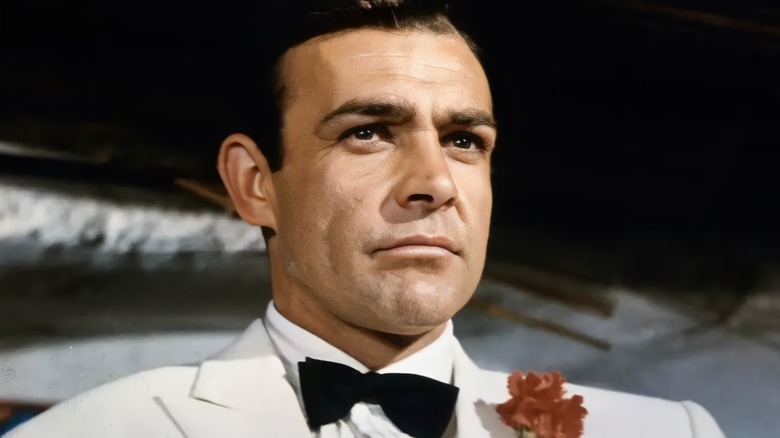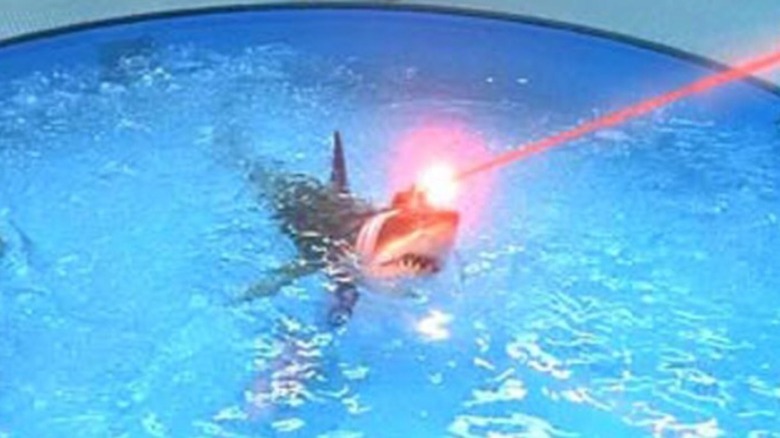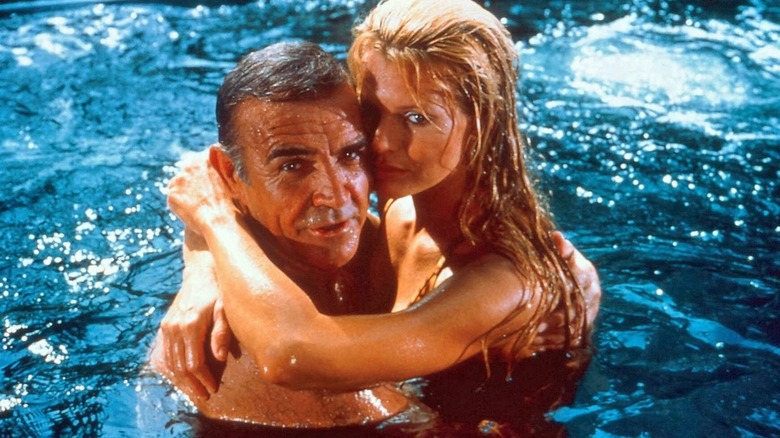Sean Connery Wrote An Unmade James Bond Movie Featuring Robot Sharks
In Jay Roach's 1997 James Bond spoof "Austin Powers: International Man of Mystery," the film's villain, Dr. Evil (Mike Myers), aims to murder off his arch-nemesis by dropping him into a tank full of man-eating sharks. In a supervillainous twist, the sharks will be equipped with laser beams affixed to their heads. Dr. Evil says he likes his pets to have a well-cooked meal before eating. He then cackles maniacally. A lieutenant of his, however, informs Dr. Evil that buying sharks equipped with lasers is immensely difficult and that the tank is, instead, filled with flesh-eating sea bass. Dr. Evil isn't thrilled. "You know, I have one simple request," Dr. Evil says, "and that is to have sharks with frickin' laser beams attached to their heads!"
One cannot say if there's a direct connection to the above scene and a James Bond movie that Sean Connery once wrote, but there are a few uncanny similarities.
Back in 1983, thanks to an obscure legal loophole, the James Bond franchise had bifurcated. Roger Moore was still playing the stalwart 007, and he appeared in the Eon-produced film "Octopussy" in July. Only four months later, Sean Connery returned to play James Bond for the first time in 12 years, starring in Irvin Kershner's non-canonical "Never Say Never Again." This was confusing for Bond fans, but fine for Connery who spoke to Rolling Stone about it at the time.
Connery revealed that he was initially tapped to return to the 007 franchise initially as a writer. He and author Len Deighton were to write a wholly original James Bond script and another actor was to play 007. Eventually, Connery's script was abandoned, but it sounds like it would have been wild. Connery, it seems, wrote a scene where robot sharks attack New York City.
Sharks, sans frickin' laser beams
The story goes that sometime in the early '60s, James Bond creator Ian Fleming wanted to adapt his famed spy character to the big screen, and he worked on a script with a producer named Kevin McClory and a scriptwriter named Jack Whittingham. The three of them came up with an excellent plot for a James Bond movie, but the project was abandoned because it was too expensive. Later, however, Fleming allegedly used the ideas he brainstormed with McClory and Whittingham to write his novel "Thunderball." The other authors were not credited. McClory took Fleming to court and the case was settled in 1963.
In the mid-'70s, McClory started production on his own version of "Thunderball," seeing as he had the legal rights to that one story. Connery and Len Deighton (author of "The Ipcress File") came in to write a new James Bond story, and Hollywood was abuzz. Indeed, Paramount purchased the mysterious "Thunderball" redux in 1978. Sadly, it was not made.
Connery recalled his script, and it sounded amazing. The actor said:
"We had all sorts of exotic events. You know those airplanes that were disappearing over the Bermuda Triangle? We had SPECTRE doing that. There was this fantastic fleet of planes under the sea, a whole world of stuff had been brought down. They were going to attack the financial nerve center of the United States by going in through the sewers of New York — which you can do — right into Wall Street. They'd have mechanical sharks in the bay and take over the Statue of Liberty, which is quite easy, and have the main line of troops on Ellis Island. That sort of thing."
Connery's film was to be called "Warhead."
A pair of Thunderballs
Personally, I would have pressed Connery a little harder on what exactly he meant about how the Statue of Liberty was easy to take over. Is this something he has thought about doing?
Eventually, "Warhead" was put on hold for ... you guessed it ... legal reasons. United Artists and Danjaq — the current James Bond owners — felt it stepped over the line in terms of copyright. There was some debate as to who owned the rights to names like SPECTRE and Blofeld; McClory claimed he invented them, and their periodic appearance in other James Bond movies based on whatever the legal climate was at the time of their production. When McClory saw Jimmy Carter talk about nuclear proliferation in the 1980 presidential debate with Ronald "The Body" Reagan, he pivoted back to the original "Thunderball" plot.
"Never Say Never Again" had pretty much the exact same plot as "Thunderball," with the same villain and similar world-ending stakes. The new version merely boasted a James Bond in his 50s, Kim Basinger, a holographic video game, and mercifully fewer underwater scenes (the underwater climax of "Thunderball" is one of the most boring action scenes in the history of the genre). Lorenzo Semple, Jr. is the only credited screenwriter on "Never," although TV writers Dick Clement and Ian La Frenais were hired by Connery specifically to rewrite the entire script, and continue rewriting during production.
Ian Fleming sued to stop production, but McClory was in his rights. Thanks to his efforts, the James Bond franchise has one impishly non-canonical entry and nerds have been debating about it ever since its release.


